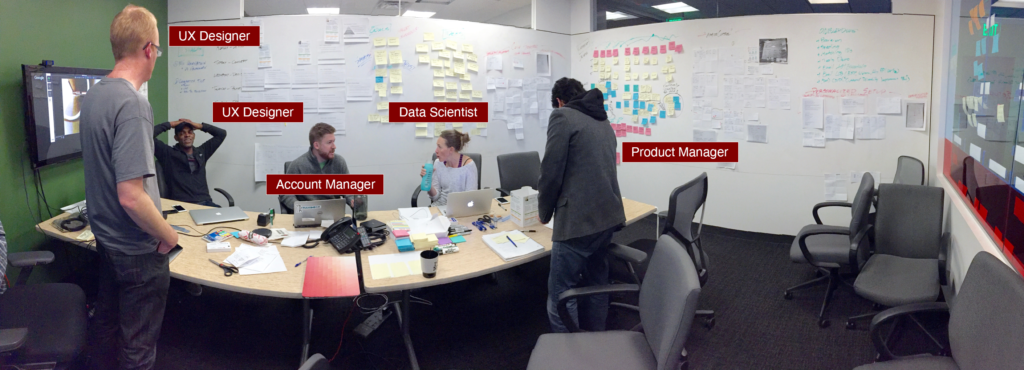
My Role
Sprint Director
Responsibilities: Planning, leading, facilitating, stakeholder management, moderating customer validation sessions, and prioritizing the next steps.
Problem
Envision a completely new experience for Return Path customers – focused on their primary needs and workflow to manage their email deliverability and engagement.
We needed to rapidly come up with a new experience for our customers and wanted to have a cross-disciplined group: Product, UX, Engineering, Data Science, and Account Management work together to concept and prototype solutions and test with customers in a week.
Process
We followed the Google Ventures Design Sprint plan.
- Day One: Learn – learn about the problem, users, and competition.
- Day Two: Create – rapid sketching sessions around focused problems.
- Day Three: Decide – from dot voting and prioritization, choose one or two most compelling solutions.
- Day Four: Prototype – get something built rapidly that you can put in front of real people and get feedback.
- Day Five: Test – have 3-5 primary users scheduled and walk them through the prototype, listen, learn, and then iterate.
Learn
Establish what we currently know about our customers – their context, goals, problems to solve, and jobs to be done – from our continual research as well as inviting our Customer Services representatives to give us their current perspective and insight.
We set our Shared Goals and kicked-off the week by reviewing our Personas, Research, Customer Services Share, and then building a Customer Journey Map of our customer’s experience.
Create
After the first day of learning, we jumped right into Rapid Prototype Sketching around the primary pain points and needs of our email marketing customers. I managed this process with a local team of 6 and 2 remote participants using an IPEVO document camera for share-backs and input from the whole team.
We worked from a mobile context and a desktop (our customer’s typical use, being a B2B user), and pushed hard to establish a clear “Mission Control” dashboard to update the email marketer on the important items today and the priority items coming up for longer-term success of their program.
Decide
In reviewing the concepts and the focus from our Create Day, we moved to make decisions on what we would be our proposed solution for the final day five of testing with actual Email Marketers. We used Dot Votes to highlight the shared confidence areas for our team to prototype around and set out to build.
From our rapid concepting, voting, and discussions, we honed-in on two primary concepts and areas to focus on for our prototype: Establish an alerting system and Problem Overview (if they had any issues with their email program deliverability) and then a clear Problem Checklist (we nicknamed the prioritized problem machine the “Coin Sorter”) to guide them to solve it with best-practice suggestions, giving them full control along the way.
Prototype
We used a quick click-through wireframe to put the pieces together. We highlighted a “Monitor” area for an “all systems go” mission control and a secondary section focusing on an “Optimize” section that would be future-forward showing the marketer how to strategically focus on the right things now to create more opportunity going forward.
We also worked with incorporating an “ROI Calculator” concept that our Customer Support team and other customers have started to think about. This was intended to have a clear revenue-increasing driver for the email marketer (and could also start to demonstrate a clear ROI of Return Path’s dashboard and optimization toolset).
We spit up the work with three UX Designers building out separate sections of a Sketch to Invision prototype.
Test
Finally, after prepping the prototype we got to the fun part, getting it in front of real Email Marketing leaders and teams.
I led and moderated the feedback sessions and we spoke with current and churned customers about this concept, using the wireframe click-through prototype. We recorded their sessions, created a summary slide for each (noting their respective persona-match) with pull-quotes and links to the full Notes and Recordings for the rest of the team.
Then wrapping it up, I focused on sharing what we learned and what the suggested next steps could be.
Solution
From that feedback, we had greater confidence to push further into a solution, and our UX Designer designed a Full UI Prototype with Sketch and Invision and I set up follow-up sessions with more Email Marketers to get their feedback and iterated from there.
We also recorded our process with a documented “Design Sprint Primer” for future teams to utilize and expand upon.
We had two other Design Sprints follow-up on other teams using this basis and increasing the “speed-to-concept” with a shared team input for their customer solutions.
Takeaways
This was a great experiment. The time of collaboration and the time box was exceptionally valuable. It brought a group of diverse disciplines together to really focus on solving problems for our customers in a short amount of time.
I have taken this methodology and continued to use it in my practice, whether a full week or more typically a 1.5-hour rapid sketching session or a half-day concepting with cross-department groups to give UX Design a jump-start with shared team input.
Here is what I would do differently:
- Preload learning – provide resources and send out a Sprint Prep Packet to help participants get on board with current research, competition, and knowledge to speed up the Learn phase.
- Share leadership – this was a quickly planned sprint. I would recommend having different people lead different sections and not relying on only myself to lead the full week all the way through.
- Have everyone local – keep everyone in the same room, we worked with remote participants and found some good remote collaboration methods, but it was still a challenge to keep everyone connected.

















